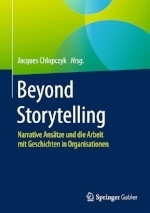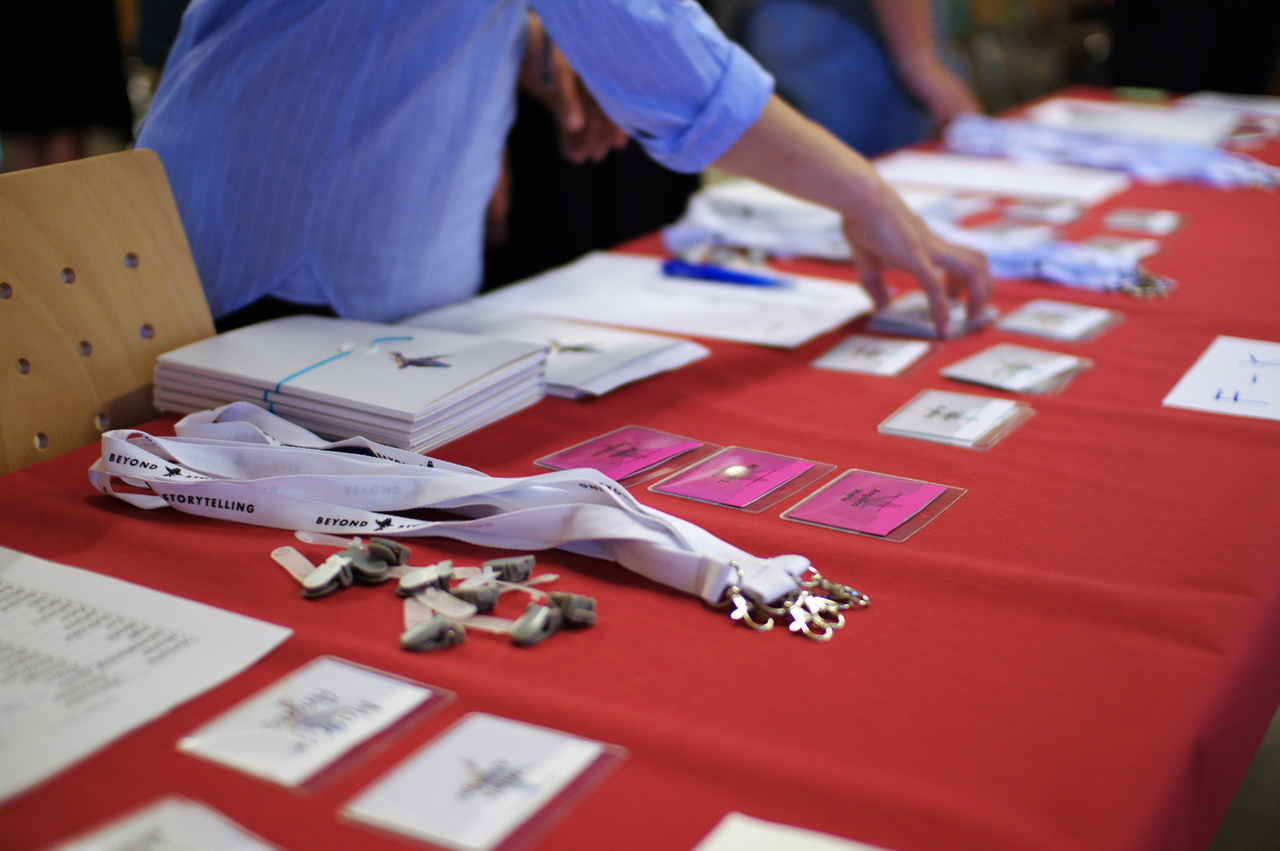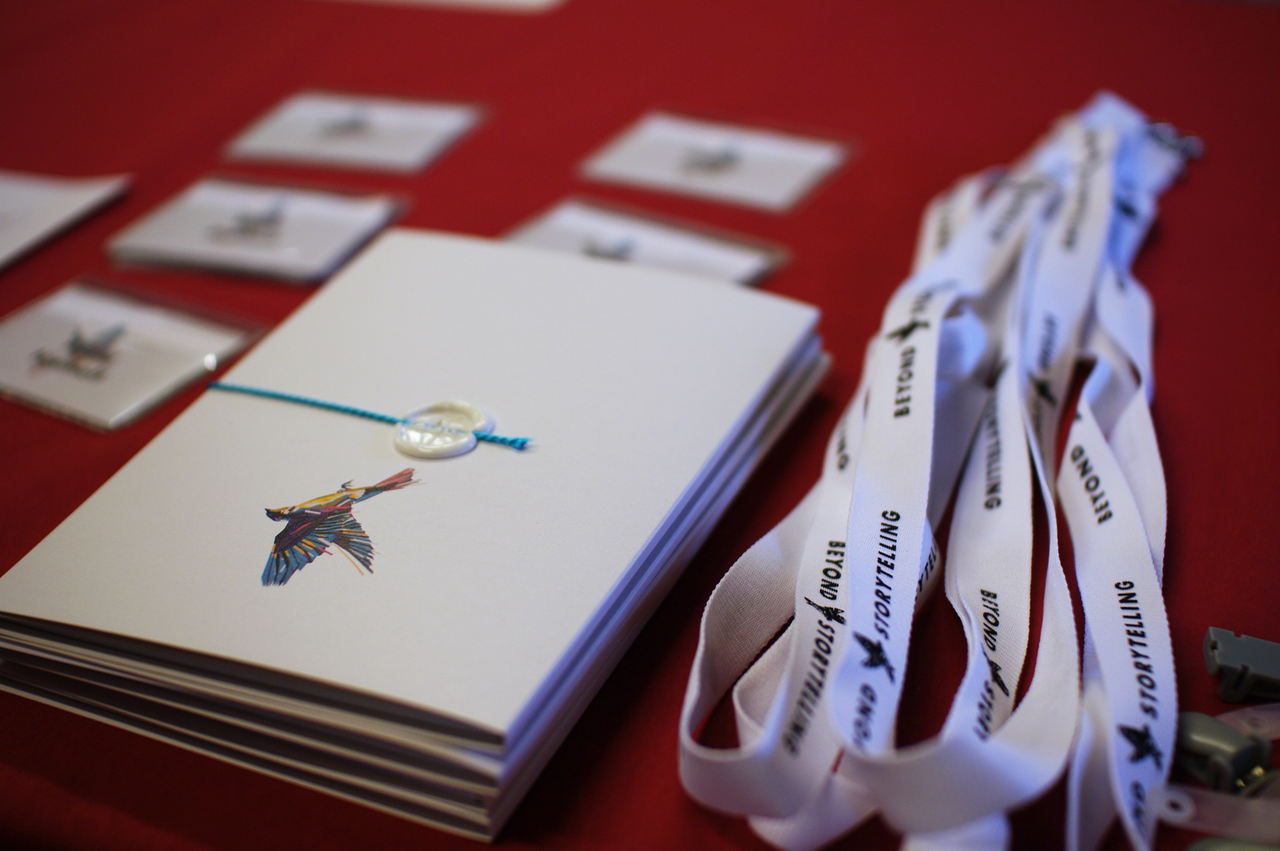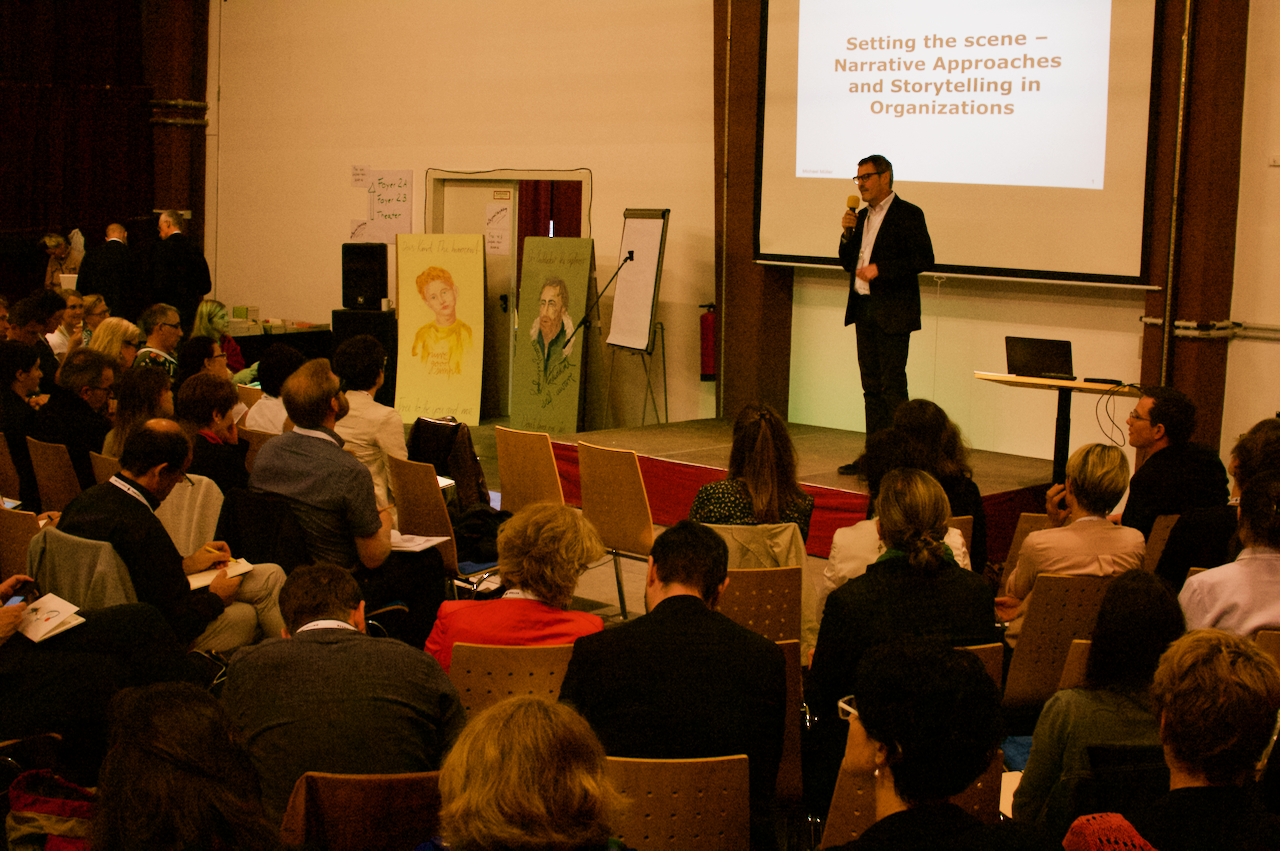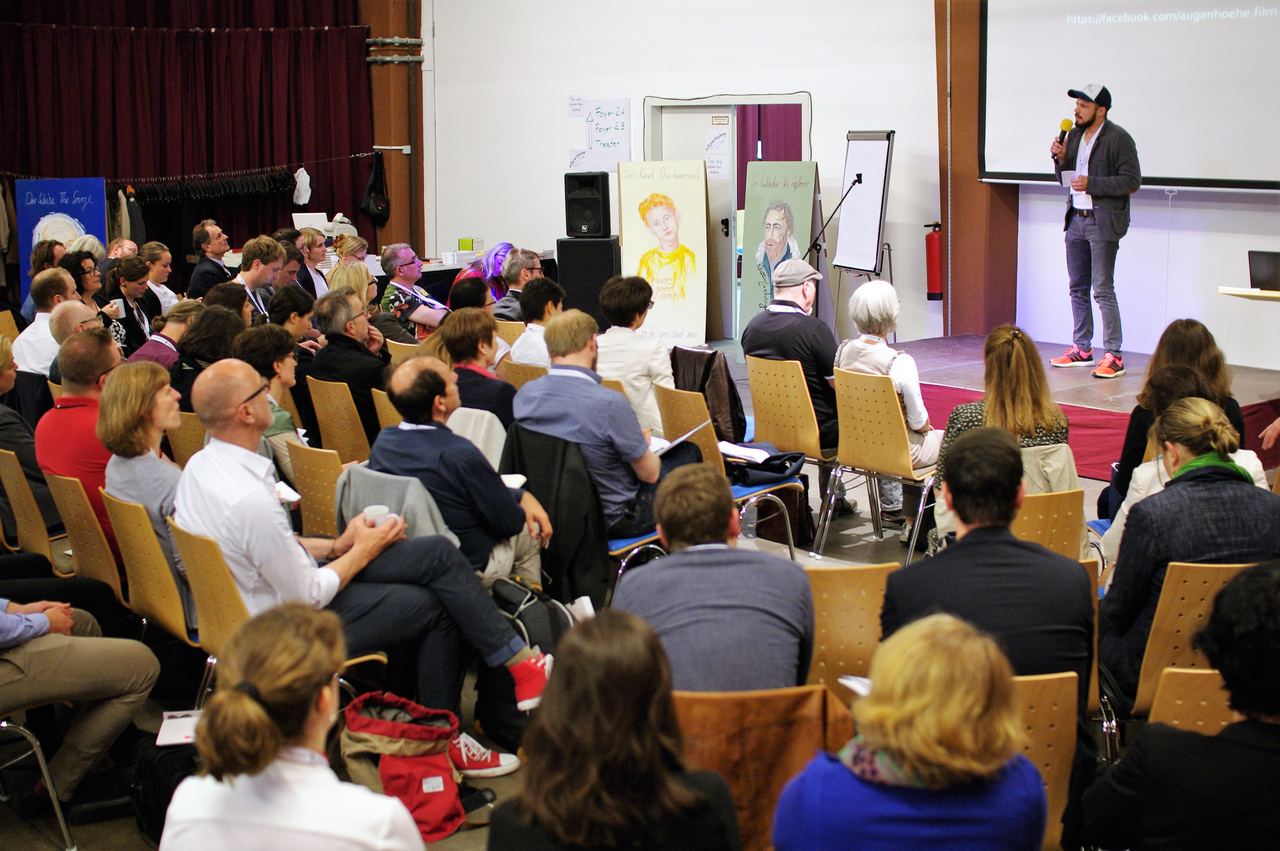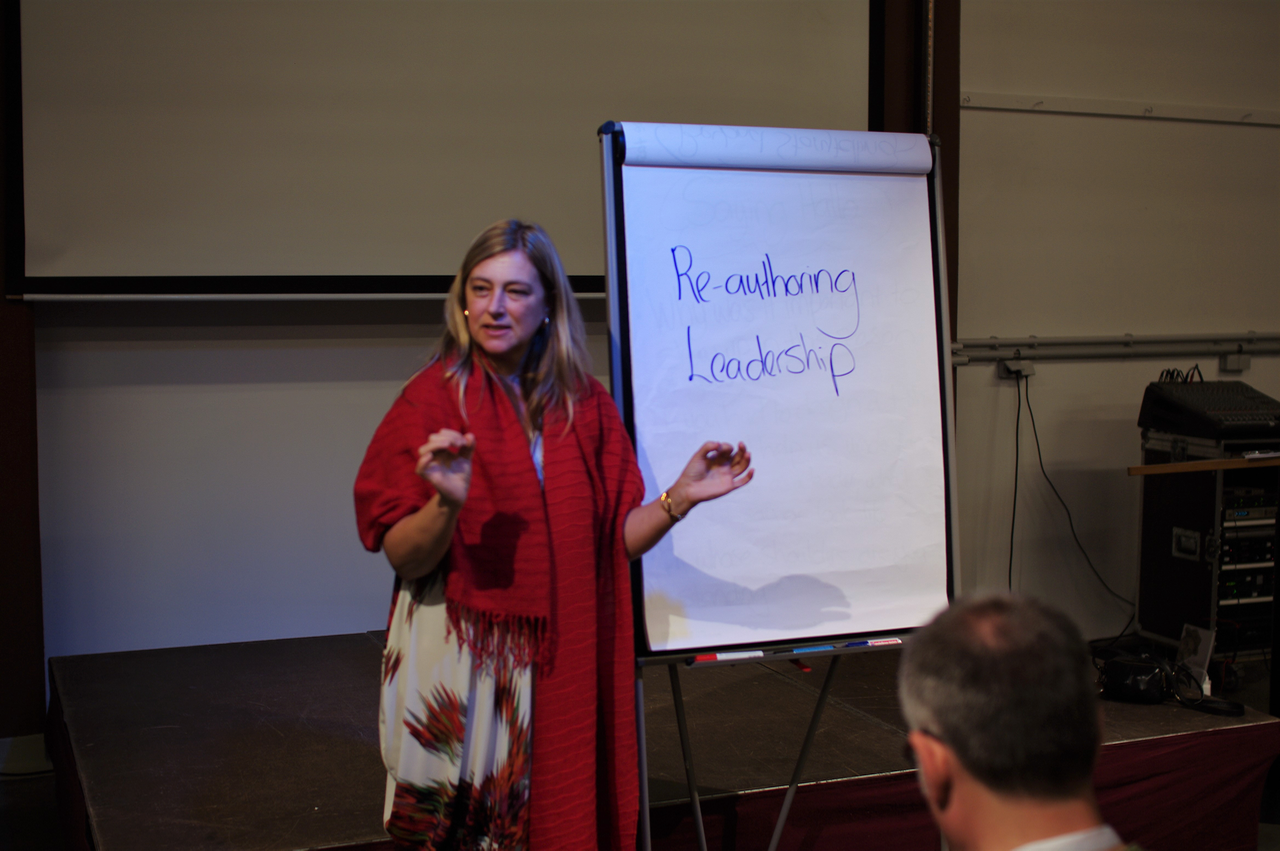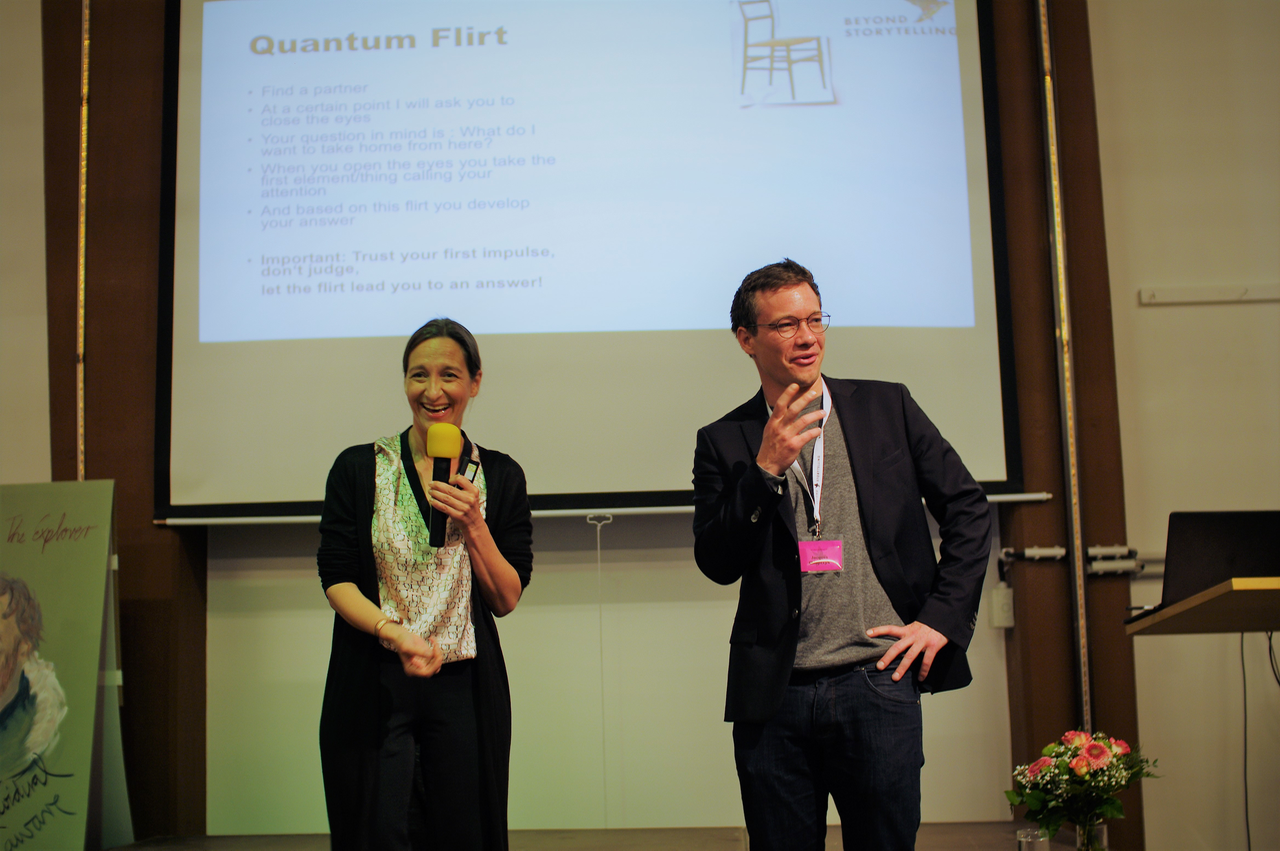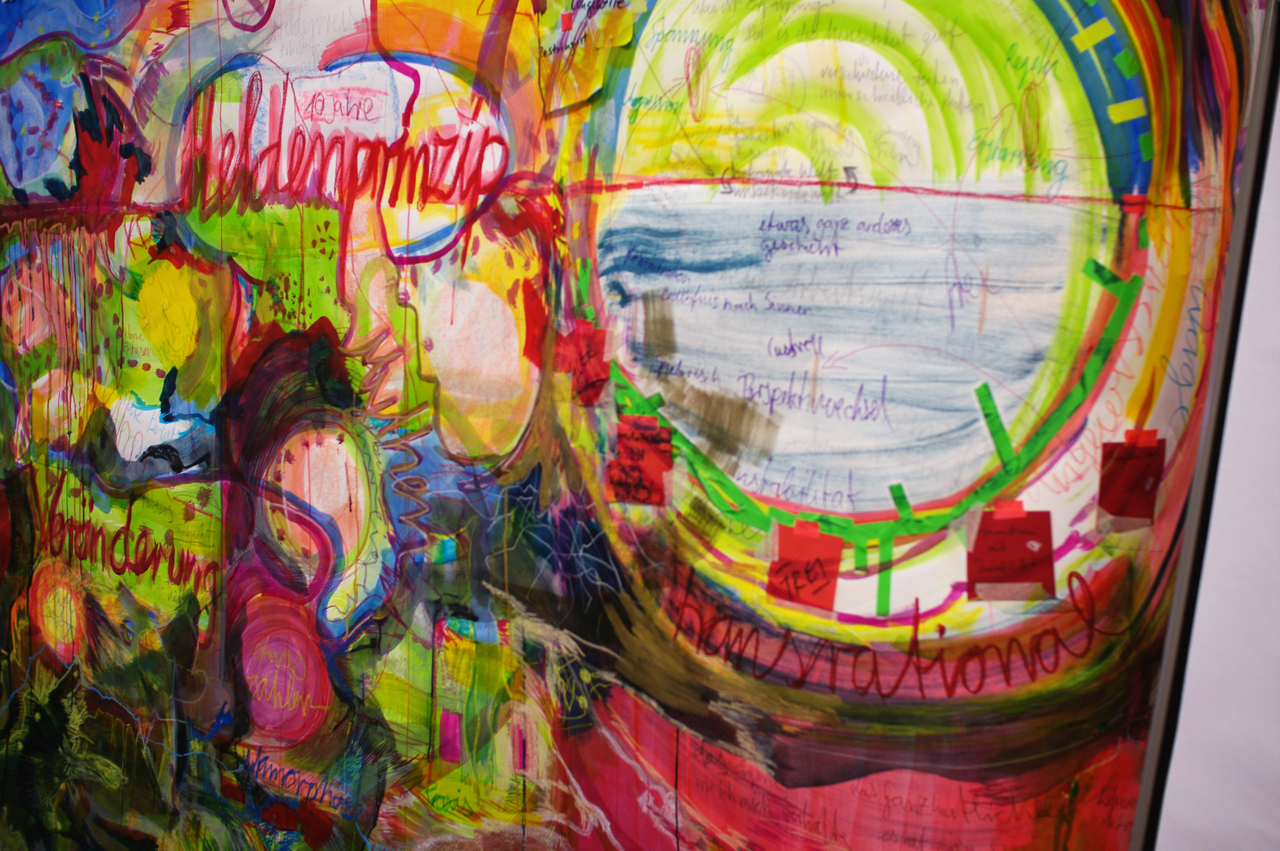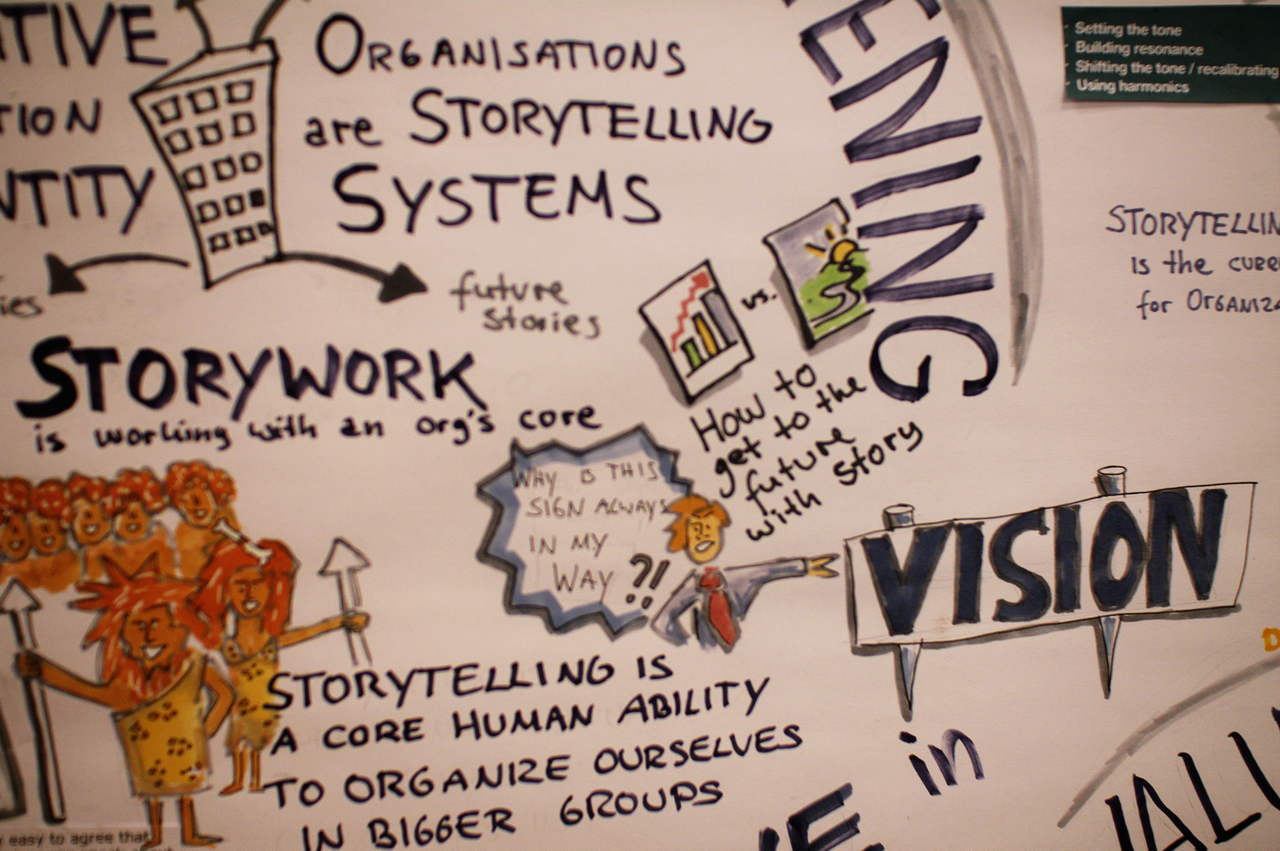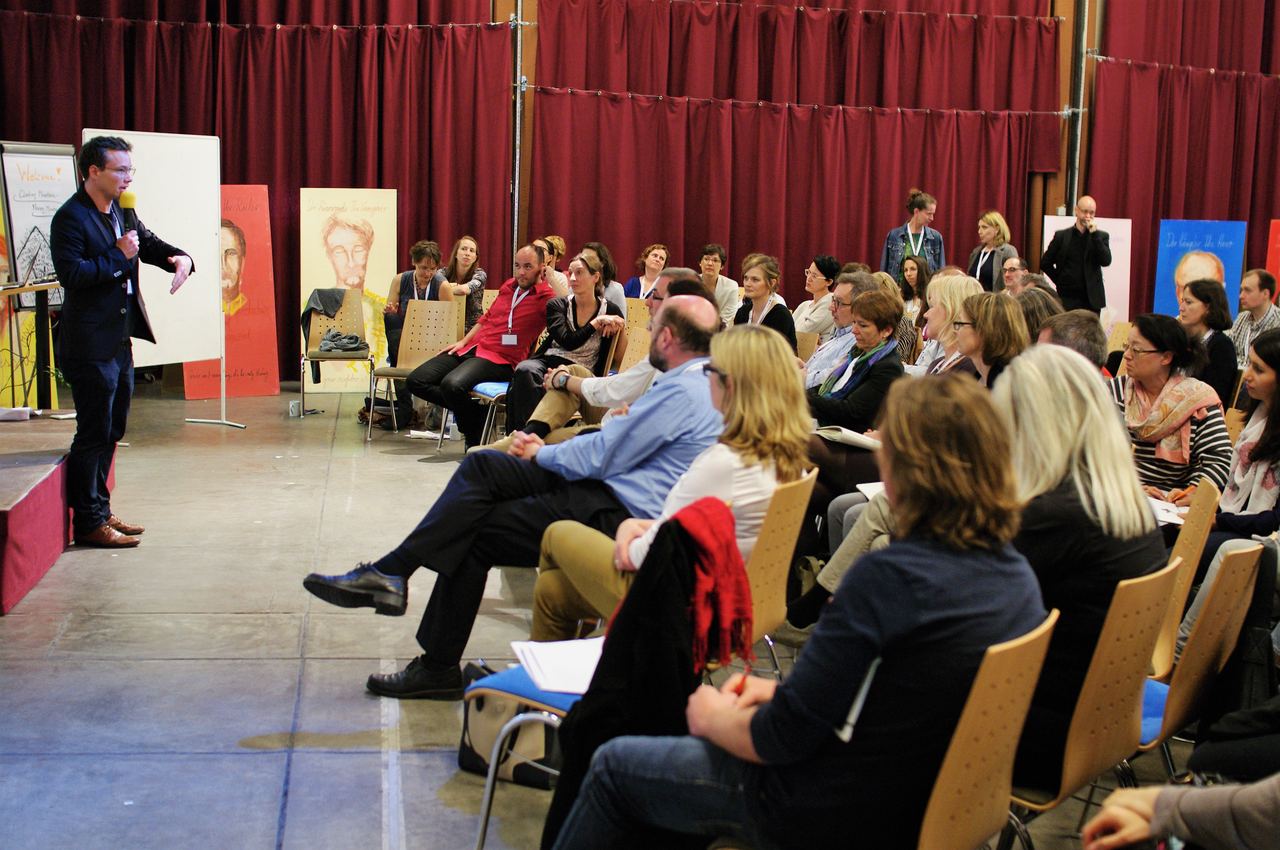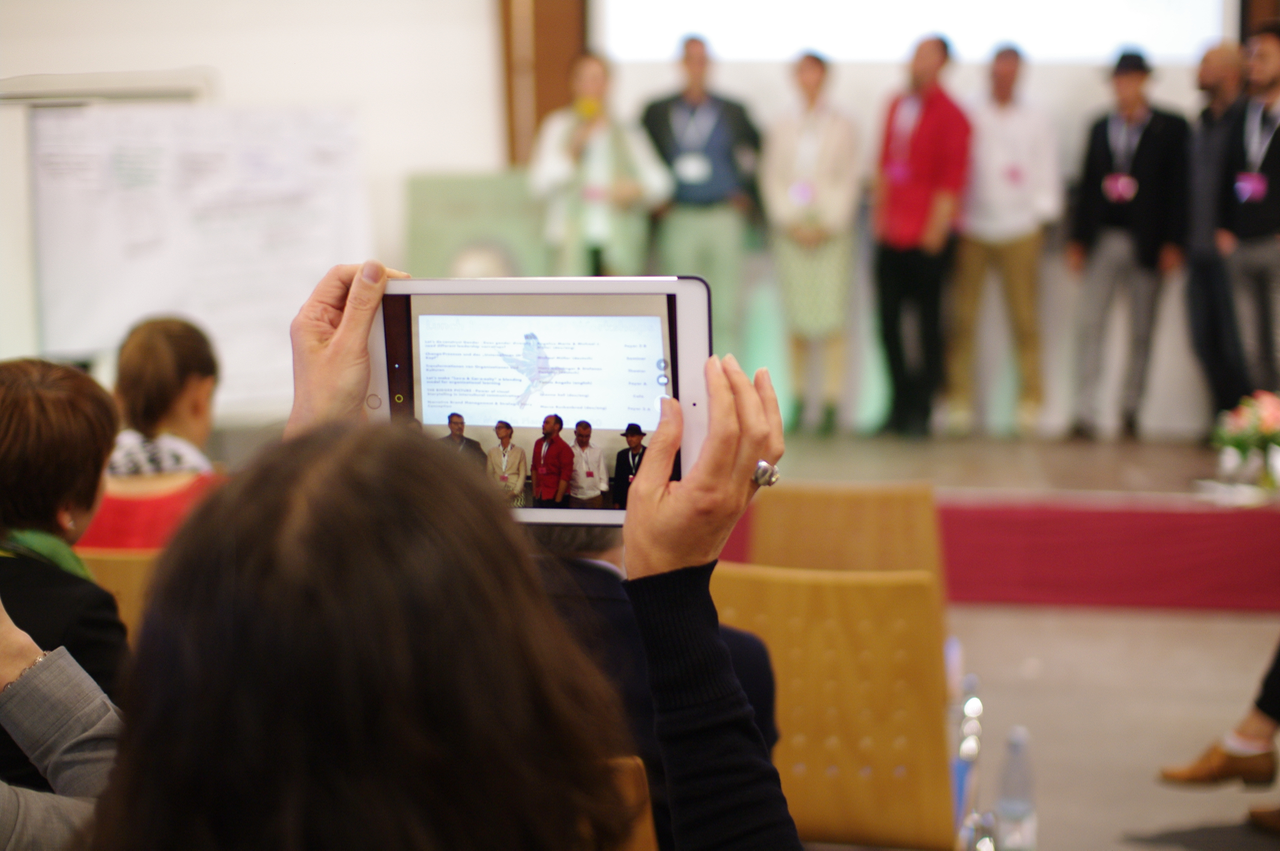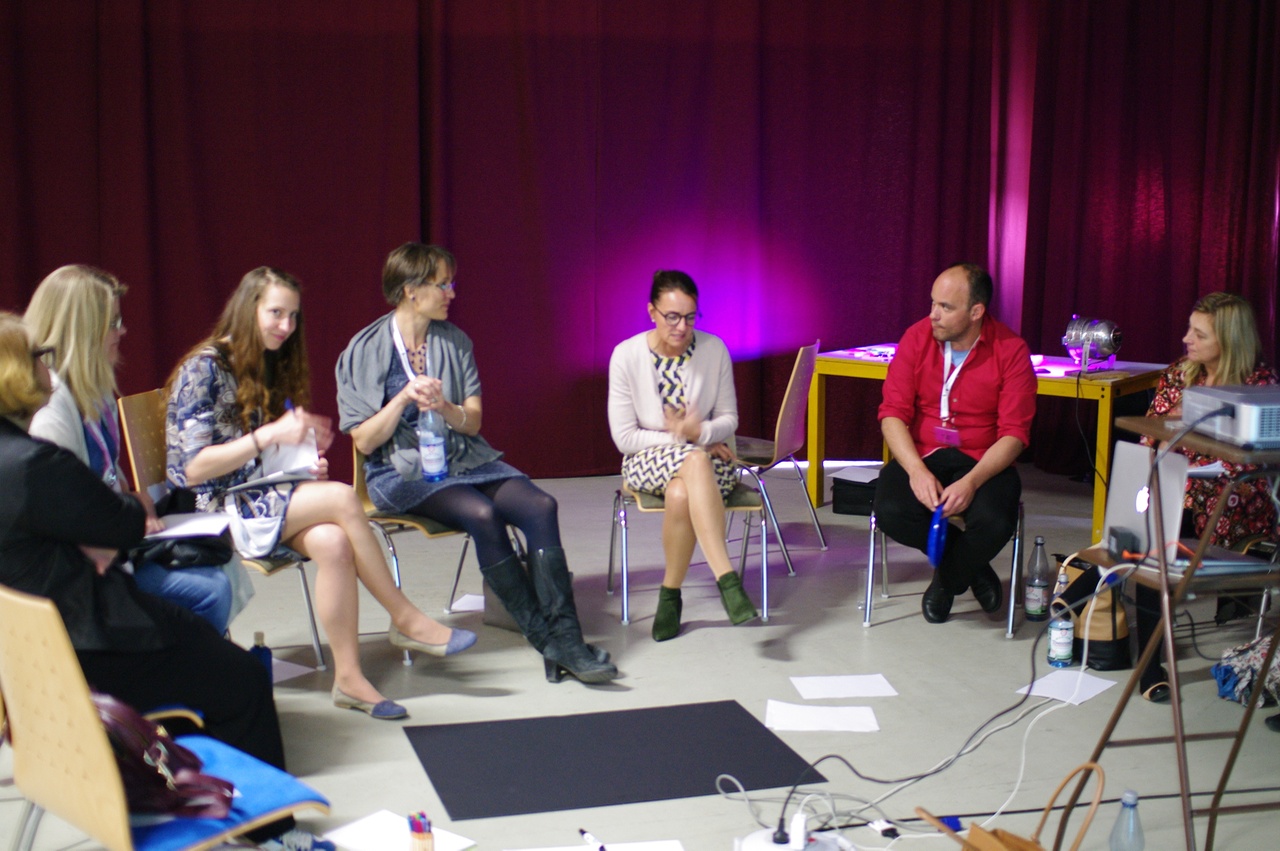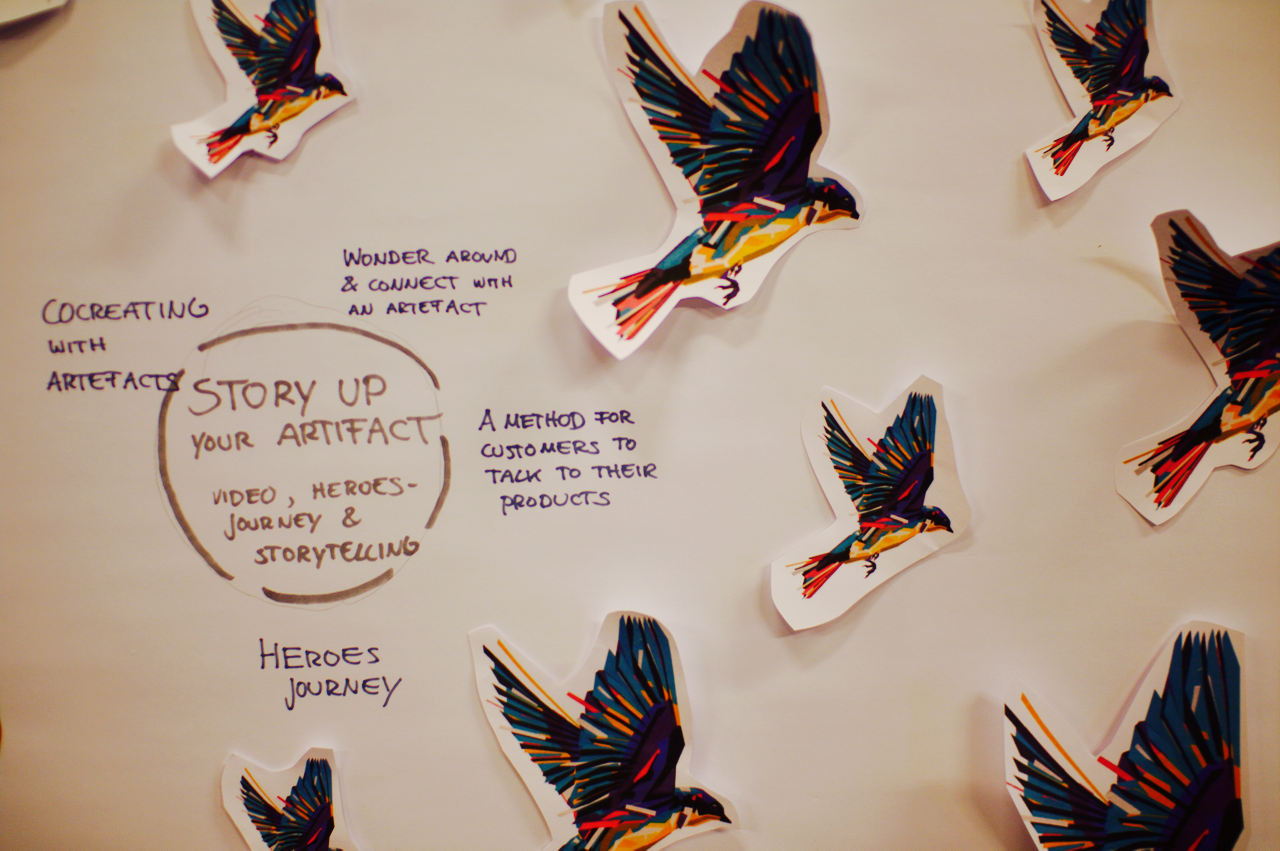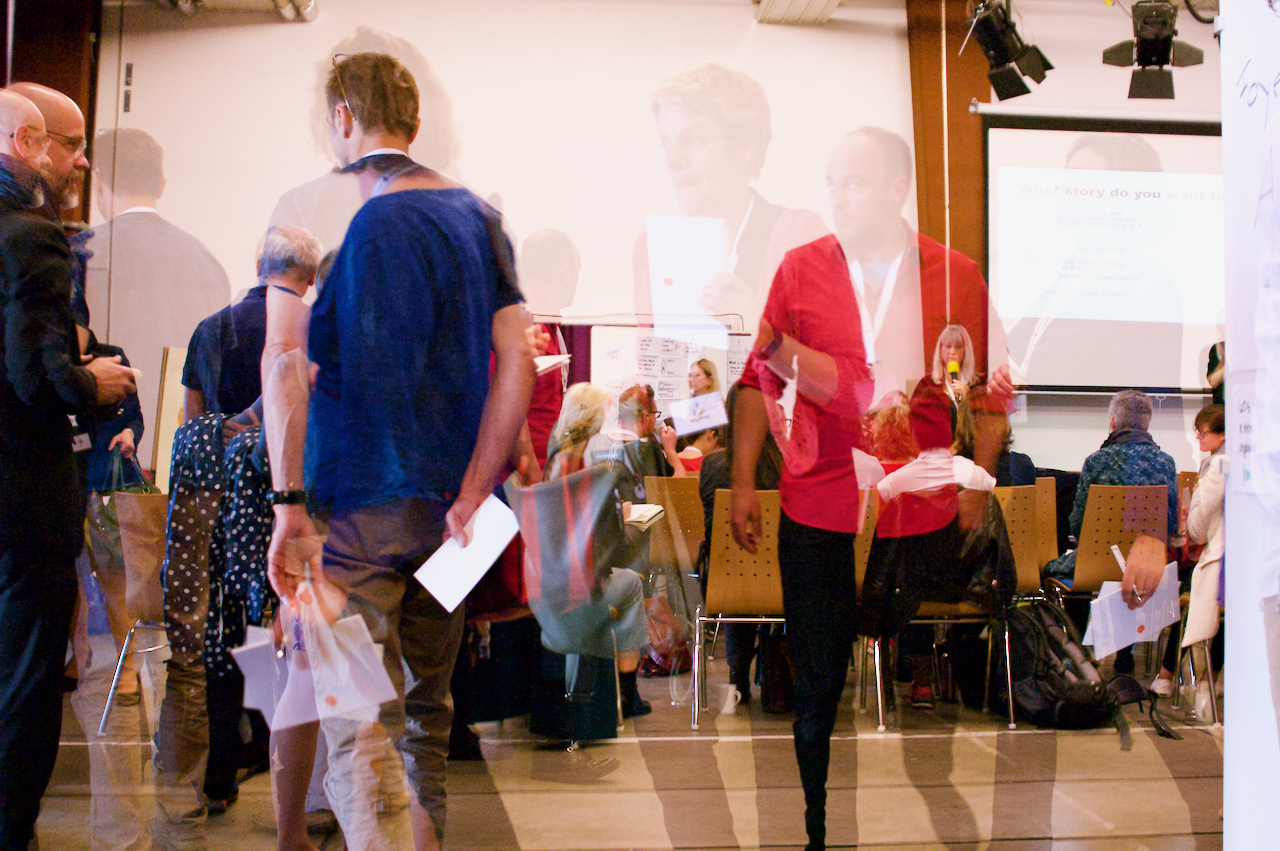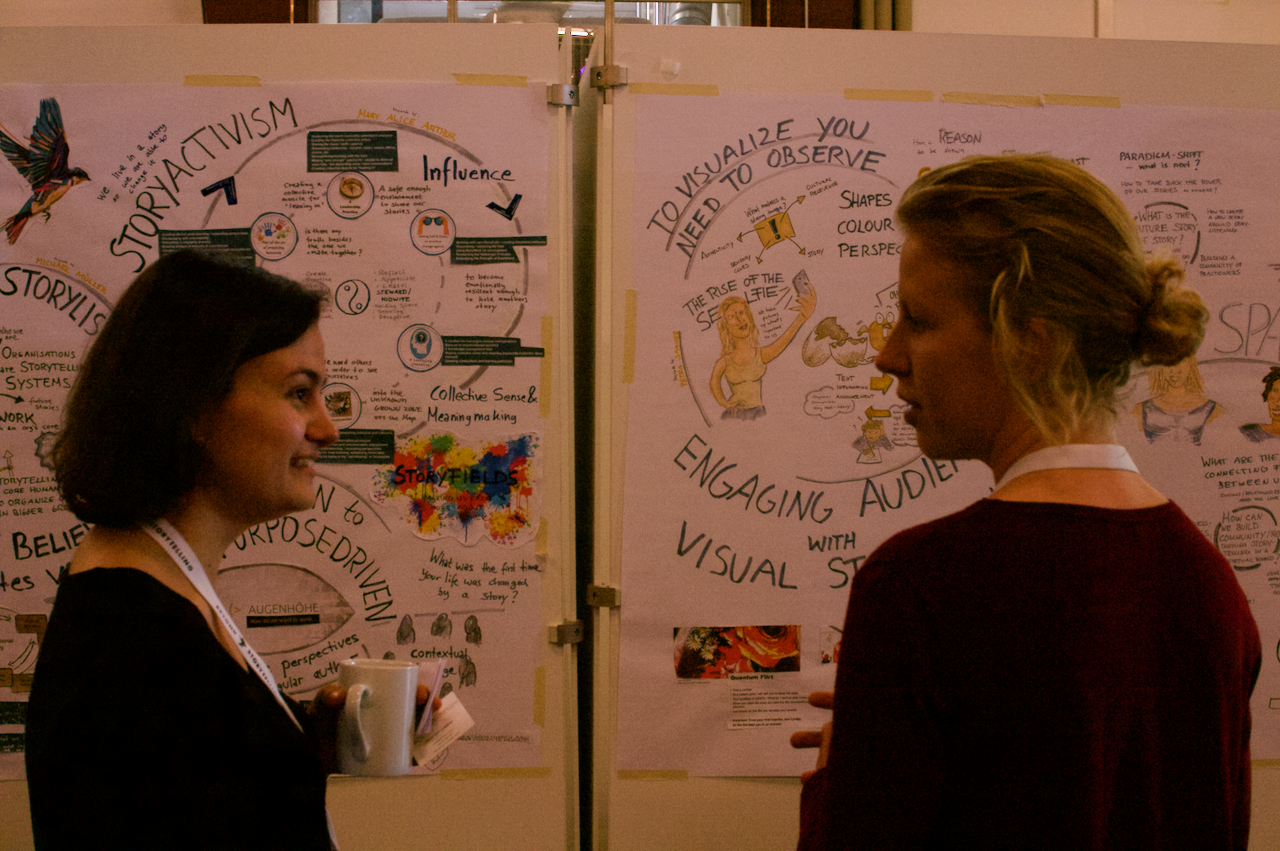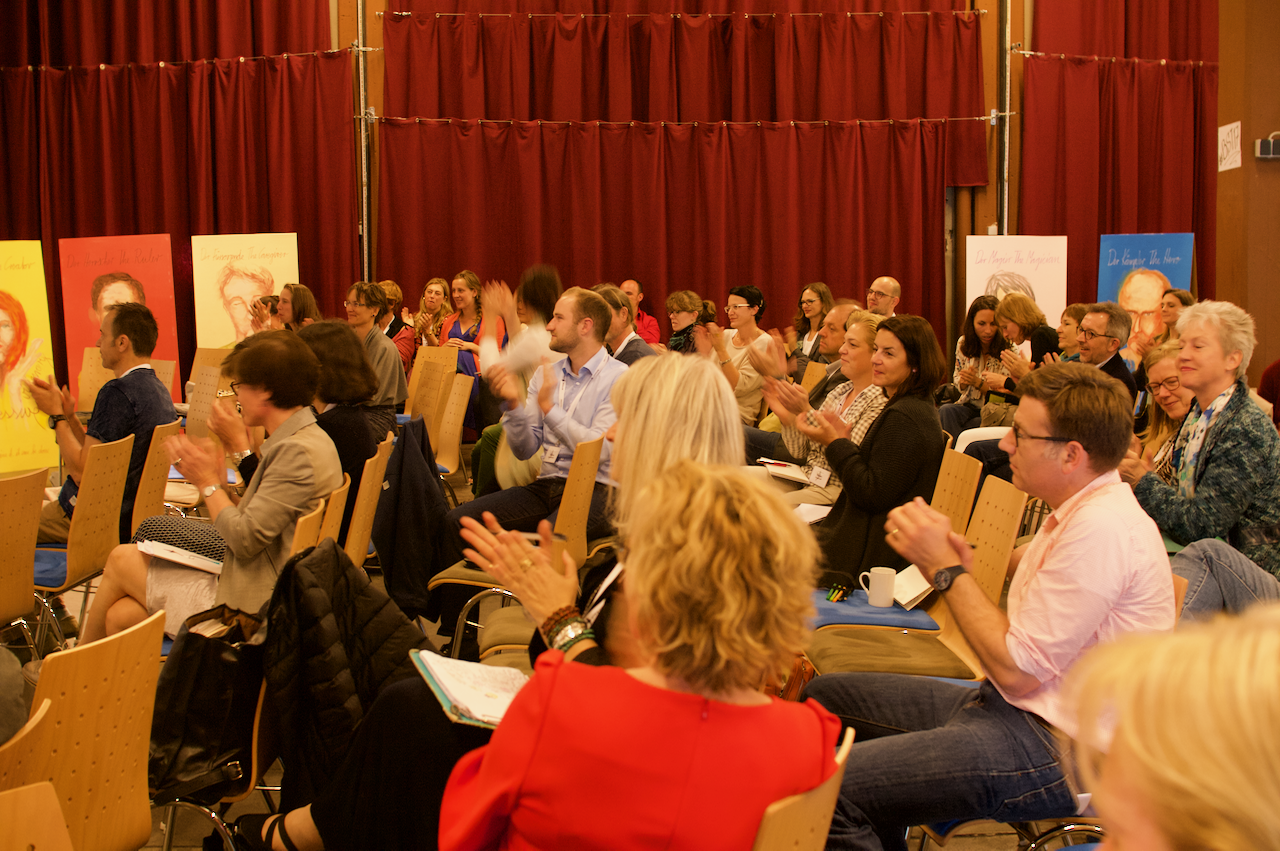Unser Kollege Heimo Tscherne hat eine knackige Zusammenfassung von BEYOND STORYTELLING aus Sicht von PR und Marketing geschrieben:
Christine Erlach über die wahren Schätze: Communities
Christine Erlach mit einer kurzen Reflektion über die wahren Schätze – Communities of Practice:
Die wahren Schätze im Arbeitsleben? Das sind für all jene Experten, mit denen ich sprach, ihre Communities! Ich kann mich ihrer Meinung nur anschließen: Die Gewissheit, „da draußen“ Menschen zu kennen, die ähnliche Interessen verfolgen, Fachwissen und hohe Kompetenzen haben und die gerne und bereitwillig ihr Wissen und ihre Arbeitszeit einbringen, um einander zu helfen, ist in der Tat ein wahrer Schatz – dies gilt umso mehr in einer zergliederten Arbeitswelt, die uns einen Großteil unserer Arbeitszeit an Bildschirme und einsames Tippen in die Tastatur zwingt.
Enjoy: http://www.narrata.de/aktuelles/die-wahren-schaetze-gute-communities/
Mary Alice Arthur´s Harvest – Part 3 – Two ways story can power humanity's future
The third part of Mary Alice´s harvest of BEYOND STORYTELLING and her keynote is now online. Check out her post here: https://www.linkedin.com/pulse/beyond-storytelling-3-two-ways-story-can-power-humanitys-arthur
Niklas Gaupp on The Possibilities of Narrative Management – Michael Müller’s Approach to Organizational Consulting
In an inspiring introductory keynote, Michael Müller laid the groundwork for our journey “beyond storytelling” by providing us with a comprehensive summary of what the field of narrative management is about.
Michael Müller started out as a self-employed communications consultant 20 years ago, and is now not only one of the leading experts in the field of narrative management consulting but also professor for media studies and director of the Institute for Applied Narratology at Stuttgart Media University.
Michael Müller began his career with the observation that one learns more about an organisation over what gets said during a coffee break than what you find in the company brochure. Having studied literature among other subjects, Müller recognized the significance of these findings and turned what was merely a curious observation into an elaborate approach to organizational consulting.
Whilst Müller’s method would come to be known as the practice of “storytelling”, it could have initially been more accurately described as the practice of “listening” to stories. Only later did the focus shift to systematically looking at possible interventions once “the company in the mind of the employees” had been accurately described. This is how storytelling as an approach to organizational consulting came of age.
Müller emphasized that “storytelling” is not comparable to the many buzzwords in management literature that gain widespread currency before becoming a trend of the past. Rather storytelling belongs to the depth of Man’s cultural heritage. As pointed out in Yuval Noah Harari’s best seller Sapiens: A Brief History of Humankind (2014), the ability of humankind to construct and tell stories has been crucial to the survival of groups of 150 people or more. To borrow from the title of Jonathan Gottschall’s recent work, we are The Storytelling Animal (2012). Indeed, with our natural tendency to live and coexist together in large groups, applying the art of storytelling to an organisation is the logical conclusion.
When working with stories, the first thing that comes to mind is the subject of identity. Developmental psychologists argue that it is through stories that identity is constructed. This is no less true for organizations as well – with broad implications for the experiences employees and customers make and the placement and perception of products and services in the marketplace. Müller specified three areas that need to be distinguished when dealing with corporate identity: the external narrations (how customers, media and partners view the company), the internal narrations (concerning internal developments, experiences and projects) and the contextual narrations (related to society and history). However, whereas the importance of external narrations is widely acknowledged, for example when a major scandal necessitates a wholesale rebranding effort, internal narrations must also be fully embraced on an executive level.
The second crucial dimension in dealing with this task and corporate storytelling is that of time. It follows then that there are three angles from which to look at the subject: past, present and future. When exploring the past of our stories, the focus is on learning and gaining knowledge: how did stories develop, how do they define and predetermine who we are today? In the present, storytelling is crucial to how we act and communicate: what is the story we’re telling right now? This leads to the possibly decisive question for the long-term survival of a company: what is the story of our future? This is the area where storytelling skills are most often lacking. Many companies have no stories of their future, only a corporate document which cannot generate the necessary motivation to join in. In interviews, employees then often say: “we don’t know whether we have strategy”, whereas executives emphatically contradict: “of course, we do – we communicated it so many times”. When employees think of their company’s future, it’s hard for them to relate to a fact sheet.
In addition, when stories of the future are crafted, the essential role of the past is often overlooked. Following Jens Beckert’s Imagined Futures (2016), one must take into account that a good future story has to relate to and build on the past. Corporate stories often revolve around a main event which is not part of the “official” identity of the company but looms large in the “experienced” identity of its employees. In one company Müller consulted, many events in the past had led to the overarching story that change projects never get finished and fail anyway. This was the reason no one wanted to join a new change effort, as employees understandably didn’t want to be part of a failing project. The solution was to change that story by starting a relatively easy small-scale change project that was able to dispel the belief that “change projects never get finished”. Small change makes big change possible.
Müller’s final warning was to be aware of too simplistic a future story: “more, more, more” is not the recipe for a good story. Such straightforward stories are mostly unbelievable and almost always hard to relate to. Therefore, it makes sense to study the art of storytelling, and it is not a coincidence that the best and most convincing storytellers, such as Steve Jobs in the case of Apple, often build and develop the world’s most successful companies. The study of stories can help us navigate the cunning passages and contrived corridors of what is actually going on in an organization, and it is the art of narrative management that uses this as the foundation to lead a company into its successful future.
Niklas Gaupp works with narrative approaches in the area of change management after having received his doctorate from Oxford University for a thesis on Niklas Luhmann’s systems theory. He helped with and participated in the 2017 Beyond Storytelling Conference in Heidelberg.
Further readings:
Müller, M.: Einführung in narrative Methoden der Organisationsberatung. Heidelberg: Carl-Auer 2017.
Harari, Y.N.: Sapiens: A Brief History of Humankind. London: Random House 2014.
Gottschall, J.: The Storytelling Animal: How Stories Make Us Human. New York: Houghton Mifflin Harcourt 2013.
Beckert, J.: Imagined Futures: Fictional Expectations and Capitalist Dynamics. Cambridge, Massachusetts: Harvard University Press 2016.
http://www.narratives-management.de/
Tagung: "Narrative des Populismus" – 30.06.2017 – Hochschule der Medien Stuttgart
Am Freitag, 30. Juni 2017 veranstaltet das Institut für Angewandte Narrationsforschung (IANA) die Tagung „Narrative des Populismus: Erzählmuster und –strukturen populistischer Politik“ an der Hochschule der Medien Stuttgart. Im Rahmen der Veranstaltung beleuchten, analysieren und diskutieren Experten aus verschiedenen Gebieten in spannenden Vorträgen und Diskussionsrunden die narrativen Diskurse sowie die grundlegenden Erzählmuster und Strukturen populistischer Politik. Die Tagung gliedert sich in drei Themenblöcke und ist offen für alle, die ein Interesse an Politik und Storytelling teilen. Als Keynote-Speaker referiert der Philosoph und Autor Dr. Daniel-Pascal-Zorn (Autor des Buches: Logik für Demokraten: Eine Anleitung).
Narrative Strukturen im politischen Diskurs
Im ersten Themenblock legen zunächst Prof. Dr. Markus Arnold (Universität Klagenfurt) und Dr. Wolfgang Bergem (Universität Siegen) den Aufbau sowie gängige Muster von Erzählungen im politischen Raum dar. Anschließend werden die präsentierten Erkenntnisse unter Einbeziehung des Publikums diskutiert.
Medien und populistische Narrative
Der zweite Themenblock rückt die Zusammenhänge zwischen der medialen Berichterstattung und der Verbreitung von populistischen Erzählungen in öffentlichen Diskursen näher in den Fokus. Hierzu referieren Dr. Frank Gadinger, (Käte Hamburger Kolleg / Centre for Global Cooperation Research an der Universität Duisburg-Essen) und Prof. Dr. Friederike Herrmann (Kath. Universität Eichstätt-Ingolstadt).
Guter und schlechter Populismus?
Zuletzt widmen sich die Referenten Dr. Jens Borchert (Goethe Universität Frankfurt am Main) und Prof. Dr. Karin Priester (Historikerin und Politikwissenschaftlerin) der Unterscheidung zwischen gutem und schlechtem Populismus und zeigen jeweils Merkmale der beiden Richtungen auf
Weitere Informationen und Anmeldung zur Veranstaltung hier: http://www.narrationsforschung.de/veranstaltungen/
Wolfgang Tonninger – Heidelberg Connection #beyondstorytelling
Ich stehe am Gaisbergturm und blicke auf die Lichter von Heidelberg. Es ist 4 Uhr morgens und es nieselt. Der Wind, der noch vor einer halben Stunde mit den Blätterkronen der Bäume spielte, hat sich gelegt. Es ist ruhig. Ich bin ruhig. Endlich. Der Gedankenstrom, der am Ende eine einzige Gedankenschnelle war, hat sich gelegt. Die Vertikale ist wieder hergestellt und ich wieder verwurzelt. Ich bin wach. Aber anders als im Gedankenturm. Ich bin wachsam und höre den Wald in all seinen Tonlagen. Nicht die schlechteste Vorbereitung auf einen Workshop, denke ich. Über den Horizont quillt Dämmerlicht in die Nacht. Als es Zeit ist, gehe ich hinunter.
Im Zug zurück nach Salzburg lese ich, dass alle 85 Stufen, die als Wendeltreppe auf die Spitze des Turms führen, unterschiedlich geformt und orientalischen Spiralminaretten nachempfunden sind. Und dass das Mauerwerk des Turms aus Buntsandsteinquadern ohne Mörtel oder sonstige Bindemittel aufgeschichtet worden ist. "Buntsteinquader ohne Bindemittel aufgeschichtet und begehbar über 85 unterschiedlich geformte Stufen" - halte ich fest und muss an den Kongress denken, von dem ich komme.
BEYOND STORYTELLING war ein Geschenk in doppelter Hinsicht, weil nicht nur die Qualität des Angebotenen passte (mit wunderbaren Keynotes von Michael Müller, Mary Alice Arthur und Petra Sammer, kurzweiligen Workshops (zu denen ich auch einen Beitrag leisten durfte), sondern auch die Qualität der Aufnehmenden, Zuhörenden, Anreichernden und Weiterdenkenden (die Open Space Session zum Thema STORY JAMMING mit Johann L. Bota war mein persönliches Highlight in diesen Tagen, nicht weil einer so gut war, sondern weil wir miteinander, das heißt alle zusammen, in dieser Runde etwas geschaffen haben, das über unsere kleinen Erzählegos hinausging).
Mein Resümee?
Selten zuvor auf einer Veranstaltung gewesen, die so wenig Energie in Machtspielereien und Eitelkeiten vergeudete. Selten zuvor auf einer Veranstaltung gewesen, wo so viel Dialog auf Augenhöhe möglich war. Buntsteinquader ohne Bindemittel: Es war die Vielfalt der Menschen, die einen tiefen Eindruck hinterließ und es war die Einsicht, dass das beste Bindemittel für einen Kongress, der über das Erzählen von Geschichten hinausgehen will, die Menschen selbst sind.
"Beyond beyond" formulierte es der wunderbare Rik Peters in einer Kurznachricht am Tage des Auseindergehens. Der Möglichmacher dahinter heißt Jacques Chlopczyk, vor dem ich jetzt meinen imaginären Hut ziehe. Einen Hut, der mit einer Feder geschmückt ist, die ich vor 20 Jahren in Ceüsse gefunden und aufgehoben habe - am Fuße einer Klettertour mit dem Namen "Captain Dada". Finden und aufheben - das muss zusammengehen, wenn etwas passieren soll. Ich habe es immer gewusst, instinktiv. Jetzt trage ich es auf meiner Stirn. Danke Jacques! Danke Stephanie! Danke Christine! Danke Yannis! ...
Was bleibt?
Der Kongress ist zu Ende. Der Dialog geht weiter. Springt über. Jeden Tag. Der im Umfeld des Kongress gegründete ThinkTank Stories for Europe ist ein Beweis dafür. Damit wird es ein Leichtes sein, die Tage bis Hamburg zu überstehen. Am 8/9. Juni 2018 sehen wir uns wieder, wenn der Kongress BEYOND STORYTELLING in die zweite Runde geht. Und dann gibt es ja auch noch das Buch, das die eigentliche Triebfeder war, die den Kongressgedanken angekurbelt hat. Es ist pünktlich zum Kongress erschienen und wunderschön geworden.
Ich bin stolz, Teil dieser Community zu sein!
Coverbild des Gaisbergturms: Von Solaris2006 – Eigenes Werk, CC BY-SA 3.0, https://commons.wikimedia.org/w/index.php?curid=1177542
Mary Alice Arthur – Moving beyond story as a tool for influence
Mary Alice continues her harvest of BEYOND STORYTELLING and expands her future story of story to collective sense making and story as a process companion.
Check out the full article on Linkedin: https://www.linkedin.com/pulse/beyond-storytelling-2-second-wave-future-story-mary-alice-arthur
Pia Horst on the THE BIGGER PICTURE – Power of visual Storytelling in intercultural communication
I met João from Brazil at an intercultural training that I held for him and many other incoming exchange students a few months ago. After lunch, we met in small groups for our next workshop. Earlier, I kindly reminded him to be on time. Noticing that he usually came about 10 minutes late, I decided to talk to him about it. I was utterly confused when he insisted that he had been on schedule the whole time. We talked for a while and eventually I figured out that being “on time” meant something completely different to João than to me. During the workshop on "The Bigger Picture - The power of visual storytelling in intercultural communication" led by Joanna at the "Beyond Storytelling" conference in Heidelberg I recalled the encounter with João and found out what actually happened when we met.
Joanna Sell is an intercultural trainer and coach, a holder of the certificate from the Friedrich-Schiller-University in Jena. Additionally, she has got two master degrees: in European Studies as well as in Art History. This combination led her to introduce the theme of visual storytelling to the intercultural field. Originally from Poland, she now lives in Germany and focuses on intercultural trainings for the business world. Besides running her company Intercultural Compass, Joanna is an author of the book Geschäftskultur Polen kompakt (Business culture Poland compact), a game diversophy Poland in English and German and co-author of several books on diversity and storytelling. She is a lecturer at two German universities. As mentioned above, at the Beyond Storytelling conference in Heidelberg she held a workshop on the power of visual storytelling in intercultural communication. That is how we met.
“It’s a question of perspective change”, Joanna says. To dive into the workshop, we start off with a simple exercise: in pairs we present each other ordinary objects such as watches, jewelry or notebooks and the personal connection we have with them. Afterwards our partner outlines what links them to the certain object. The different stories we tell change the meaning of a regular watch or notebook entirely.
What I take from this quick exercise is that getting our point across the way we have intended can be difficult. In the next hour, Joanna provides deep insights into how we can make sure that something is interpreted the way it is supposed to. One way is to share a particular culturally related story and describe the cultural context of that encounter. Telling a story about how I grew up with punctuality being instilled in me as an important value and the significance of being on time in Germany helps my partner to fully grasp the meaning I connect with a watch. It might have helped João when he tried to understand my perception of time and punctuality, in particular.
Three steps to getting a message across without misunderstandings are necessary: describing, interpreting and evaluating. “We interpret immediately according to our cultural background”, Joanna points out. We need to remind ourselves and have the openness to accept that there are several realities and all of them are okay. If the person I communicate with interprets my words differently, that’s because they base their interpretation on a different set of stories. Hence, exchanging not only facts but also interpretations as well as explaining how we relate to something, as part of the third step, is essential.
So, how do we encourage people to exchange on a deeper level? A possible way is to sensitize them to cultural differences, but also highlight similarities. When we interact with another person, we only see very few details from their cultural imprint in their behavior and the assumptions and interpretations we immediately make, originate in sometimes only one short conversation. That’s why it could be helpful to take one step back and zoom out. When we don’t focus on little details anymore, we realize that there is not only black and white or right and wrong, but there are as many “rights” as there are realities. “Zooming-out delivers an overview, a big picture where diversity is minimized” (Sell 2017). “Stereotyping and biases are “our strategy to enable us to survive in an ocean of data and facts”, but those simplifications “create black and white scenarios within seconds while dealing with other people” (Sell 2015). Even on the metaphoric level, instead of comparing coconuts with peaches, why don’t we see what they have in common? Both are about establishing a relationship and yes, it might work a little bit differently in other cultures, but we are all aiming in the same direction. “When we start exchanging stories about belonging and about identities” (Sell 2017), we widen our perception and get to see the “bigger picture”, as Joanna calls it in the title of her workshop.
Beyond Storytelling in progress
After all, our main objective in intercultural communication is to reinforce the positive aspects of diversity, such as happiness in the intercultural cooperation and, furthermore, to awake curiosity during cross-cultural encounters. When we do that by telling a story, we want to focus on the “happy end” and on synergy effects rather than listing possible challenges and differences. In general, “storytelling plays an important role in intercultural communication, not only because of the cognitive knowledge it includes, but also because of the so-called “silent knowledge” that can be transmitted in stories” (Sell 2017). Its focus on building relationships and emotional involvement makes a story much more effective than sharing facts and data (compare Sell 2017).
My encounter with João also had a “happy end”: On the third day of the intercultural training he showed up even a little bit early to one of my workshops. When I brought it up, he smiled at me and said that he wanted to experience my concept of being on time and was kind of digging it actually because he didn’t have to squeeze in the last row for once.
Pia Horst
Pia Horst studies Educational Sciences and Anthropology at University of Heidelberg and has an university background in Business Psychology. She is interested in working with stories because they spark interest and nourish the longest time the memories of her intercultural training’s participants. She´s part of the BEYOND STORYTELLING support team.
Sell, J. (2015). Power of visual Storytelling, in: SIETAR Europa Journal, September - November 2015. http://www.sietareu.org/images/stories/newsletters/SE_Journal_Sept-Nov_ 2015.pdf.
Sell, J. (2017). Storytelling for Intercultural Understanding and Intercultural Sensitivity Development, in: Chlopczyk, J. (Hrsg.): Beyond Storytelling. Berlin: Springer Gabler 2017, 223-250.
http://www.interculturalcompass.com
StoryUp your Artifact – Open Space Session Harvest
The team on StoryAtelier hosted a session during our open space. "StoryUp your Artifact" took advantage of the exhibition "ShareThis" which took place in our conference venue. They invited participants to join them in contemplating the artworks through the lense of the heroes journey and build a short movie around it. Enjoy:
To learn a bit more about the beautiful minds behind this, we conducted a short interview with Astrid Nierhoff and Mélina Garibyan, the founders of StoryAtelier.
BST: What is the StoryAtelier and what are you doing?
Mélina: StoryAtelier is a social business dedicated to storytelling. We facilitate group workshops to find, tell and craft personal stories with a special focus on digital storytelling. We also conceptualize other projects and events with storytelling.
BST: What is the story behind StoryAtelier? Where does your interest for (virtual) storytelling come from?
Mélina: StoryAtelier started with a call. Both a phone call and a call for something bigger, deeply human and sustainable. I had been working for years as a communication designer in renowned agencies, when I left in order to work with my husband who had just founded his own enterprise. In my first job, I had often lacked a deeper sense of what I was doing. In my second one, my creativity wasn’t triggered as much as I was longing for. I have always loved experiencing with creative techniques and technology and was an active blogger and digitalist. I barely knew Astrid from our children’s Kindergarden when she called me. She exposed quite a bold idea of a social storytelling agency and asked me right away if I would partner up with her. My first move was to think: What?! This is crazy! But my second move was to say: Great and crazy enough, I’m in! We founded StoryAtelier in September 2015 and have been growing our passion and expertise for digital techniques and storytelling ever since.
Astrid: My first igniting moment for digital storytelling was in 2005, during a summer trip to the US west-coast. At this time I was a Phd-Student in Literature and Arts and visiting scholar at Columbia University in New York. My trip was starting with a 3-days Workshop at the Center for Digital Storytelling (now Story Center) in Berkeley. I was immediately caught by the sheer expressive and transformational power of this tool and knew I wouldn’t let that go any more. In the years afterwards, I deepened my interest for storytelling methods and eventually applied them in my work. First as university lecturer, later as publicist in history marketing and intercultural consultant. Then, in 2011, life jumped on to me. My mother got diagnosed with Alzheimers at age 55. Four years later, which felt like decades of deep dive into the cores of our humanity, I decided to create StoryAtelier but didn’t want to be alone. This is when Mélina, whose qualities and talents I had an intuition of, came into my mind…
BST: What did you do in the Open Space Session? And how did the participants react?
Astrid: We did something quite simple and intuitive. We asked people to focus on one single piece of art they chose within an exhibit. We then paired this observation with a storytelling task. In the Open Space Session the observers had to randomly pick one of twelve steps of the heroe's journey and tell a personal story about it. Since stories are shaped by the context in which they are told and the art piece changes with each observer, we relied on this mutual fertilization. The result is one single heroe's journey co-created by twelve different stories. It’s up to some point comparable with the French surrealist’s collective game „exquisite corpse“.
Mélina: The group was very active and responsive during the session. I reckon one storyteller saying later that usually contemporary art doesn't reach him. But there, staying still in front of a wrapped chair, observing and interrogating it with his task in mind, the chair started speaking. Stories began to emerge and the group seemed truly connected to the very moment they were experiencing.
BST: What are the current projects you are working on?
Mélina: besides developing regular interventions in schools and senior housing, we work on some specific projects: A broad city storytelling project based in Cologne, a project around Alzheimer's and Sports and an intercultural competence training paired with digital storytelling in an enterprise which is part of a network aiming at employing and integrating refugees.
Astrid: this last project allowed us to design a modular training for enterprises and organizations. We are now in the process of creating a second structure where we can focus on missions around corporate culture, diversity and social sustainability. People will also find us teaching at the Volkshochschule in Cologne.
Mélina: But we are also very active in the social media scene and love participating in barcamps. Once a month we organize a #DemokratieChat, where people are invited to answer 8 questions around democracy. We love to try out new things. I would also love to organize public StoryCircles…
Astrid: Can we already reveal something? In 2018 we are actually organizing a StoryCamp in Cologne. We’ll keep you updated.
You can learn more about their activities here:
Mary Alice Arthur – 6 Perspectives How Stories Work – LinkedIn Pulse
A wonderful harvest by Mary Arthur Alice on linkedin. She reflects the 6 perspectives introduced during her keynote:
- Story as a leadership practice
- Seeing self and Story as positive Change Agents
- Story as a learning practice
- Story as a process partner
- Story as a resonance tuner
- Story as part of the art of practicing humanity
Enjoy the read and follow her on linkedin!
https://www.linkedin.com/pulse/beyond-storytelling-6-perspectives-how-stories-work-arthur
A comprehensive harvest – in Dutch
Our participant and collegue Sigrid van Iersel has summarized her experiences at BEYOND STORYTELLING – in Dutch. Thank you!
http://sigridvaniersel.nl/weblog/organisatieverhalen/2017/05/21/beyond-storytelling/
#BST Twitter Timeline
Here is the #BST Twitter Timeline
Re-Narrating Work and Organizations – Augenhoehe and Re-Invention Movie Project
Augenhoehe has shaped the discourse around how we want to work and live in the future. Daniel Trebien´s key note speech showed how organizations can set up to be economically sustainable and at the same time organize in a way that caters to human needs. Based on a hugely successful crowdfunding campaign a movie emerged that shows new ways of organizing. Here is the trailer that started everything.
The official trailer for the first movie:
More videos and interviews on their VIMEO page: https://vimeo.com/augenhoehe.
Currently, Daniel Trebien is involved in another project, searching, harvesting and documenting the personal and organizational journeys behind these new ways of working. The project was initiated by Mariusz Bocian and with colleagues and collaborators from Poland, Germany, Belgium and around the globe, the team behind the re-invention movie project searches to document the unfolding changes in our workplace.
They are currently looking for organizations that are looking for a different way to organize work in a meaningful way, being sustainable in a economical, social and human way. If you want to support the project, check out their website at http://reinvention-movie.com/.
Here is their first trailer explaining the motivation and idea behind the project:
A first visual harvest of BEYOND STORYTELLING 2017
Colour in Storytelling
In the upcoming weeks we will harvest here some of the gifts and insights that emerged during BEYOND STORYTELLING 2017.
A first gift brought to us by Petra Sammer during her Keynote on "The Iconic Turn – Visual Storytelling for Engaging Audiences" was the reference to this short video on the the colours of storytelling.
Thanks for the resource and reference. Enjoy!
Narrative Intelligenz und narrative Dummheit
Cover Photo Taken at Esbaluards Museum, Palma de Mallorca
Storytelling und andere narrative Methoden werden in den letzten Jahren von immer mehr Unternehmen für sich entdeckt – nicht zuletzt deshalb, weil Geschichten Unternehmen klüger machen können: Veränderungsprojekte werden erfolgreich, wenn sie auf den erzählten Erlebnissen der Mitarbeiter aufbauen, wertvolles Expertenwissen kann durch Storytelling für alle verfügbar gemacht werden, Führungskräfte können durch Sinnstiftung via Geschichten die Mitarbeiter motivieren. Und natürlich können im Marketing starke Geschichten Kunden von den Vorteilen eines Produkts oder einer Dienstleistung überzeugen. Wenn narrative Methoden richtig eingesetzt werden, ist etwas am Werk, das man als „narrative Intelligenz“ bezeichnen könnte.
Erzählen macht den Unterschied
Denn offenbar ist es eine der grundlegenden Fähigkeiten der Menschen, Geschichten erzählen zu können, und zwar eine, die ihn von anderen Tieren unterscheidet. Der israelische Historiker Yuval Noah Harari vertritt in seinem lesenswerten Buch „Eine kleine Geschichte der Menschheit“ (München: DVA 2013) die These, dass diese Fähigkeit einer der ausschlaggebenden Parameter für den zivilisatorischen Erfolg des Homo sapiens war. Durch Geschichten kann ein Mensch von den Erfahrungen anderer profitieren: Wenn der Jäger abends am Lagerfeuer erzählt, wann und wo er eine Büffelherde gesehen hat, können die Jäger des nächsten Tages auf diesem Wissen aufbauen. Und wenn ein prähistorischer Erfinder von seinen bisher erfolglosen Versuchen erzählt, rollende Baumstämme zum Transport von Lasten zu verwenden, muss sein Nachfolger nicht all die gescheiterten Versuche wiederholen, sondern kann auf dem erzählten Erfahrungswissen aufbauen – und vielleicht so das Rad erfinden.
„Nur der Mensch kann über etwas sprechen, das gar nicht existiert (…); mit der fiktiven Sprache können wir uns nicht nur Dinge ausmalen – wir können sie uns vor allem gemeinsam vorstellen. Wir können Mythen erfinden, wie die Schöpfungsgeschichte der Bibel, die Traumzeit der Aborigines oder die nationalistischen Mythen der modernen Nationalstaaten. Diese (…) Mythen verleihen dem Homo Sapiens (…) die Fähigkeit, flexibel und in großen Gruppen zusammenzuarbeiten.“ (Harari 2013, S. 37)
Durch solche gemeinsamen „Core Stories“ schafften es die Menschen, größeren Gesellschaften eine Identität zu geben und sie zu organisieren. Während kleine Gruppen – Stämme, Clans, Horden – sich noch leicht durch direkte Absprachen und täglichen Klatsch organisieren konnten, brauchten die größeren Stadtgesellschaften, wie sie in den Jahrtausenden vor unserer Zeitrechnung in Ägypten oder Mesopotamien entstanden, Geschichten, wie sie in Religionen, Mythen oder Königsgenealogien erzählt wurden, um eine gemeinsame Identität zu schaffen. Auch alle Unternehmen mit mehr als 150 Mitarbeitern sind solche großen Systeme, die Geschichten brauchen, um zusammenzuhalten. Die identitätsstiftenden Geschichten gibt es übrigens immer, ob das Management das will und weiß, oder nicht: Wer Unternehmen berät, kennt auch die Fälle, in denen vor allem negative Geschichten unter den Mitarbeitern kursieren: In was für einem saudummen Laden wir arbeiten, welchen Lapsus sich diese oder jene Führungskraft geleistet hat, wie verkrustet und bürokratisch bei uns alles zugeht, etc. Natürlich, solche negativen Geschichten werden in jedem Unternehmen erzählt – aber wenn (fast) nur solche erzählt werden, die eine (im Sinne des Unternehmenszwecks) negative Identität aufbauen, hat das Unternehmen ein Problem. Narrativ intelligent wäre in solchen Fällen, diese negativen Geschichten wahrzunehmen und im Dialog mit den Mitarbeitern zu versuchen, die Geschichten zu ändern: „Re-authoring the company“, wie Chené Swart das nennen würde. Von narrativer Dummheit dagegen würde der Glaube zeugen, die Veröffentlichung eines Mission-Statements in Hochglanz würde genügen, um eine neue Core Story zu etablieren.
Narrative Intelligenz
Narrative Intelligenz bedeutet also einerseits, den Geschichten anderer Menschen Interesse entgegenzubringen, ihnen zuzuhören, das in ihren Geschichten vermittelte Wissen zu erkennen und für sich selbst nutzbar zu machen. Zweitens bedeutet aber narrative Intelligenz auch, Geschichten als Möglichkeiten zu betrachten, zu denen es Alternativen geben kann. Eine Geschichte ist so und so gelaufen – sie hätte auch anders laufen können, und beim nächsten Mal läuft sie vielleicht auch anders. Das bedeutet Lernen aus Geschichten. Wenn der Nachfolger des prähistorischen Erfinders die Geschichten seines Vorgängers für nicht veränderbare Faktizitäten genommen hätte und nicht an die Möglichkeit geglaubt hätte, dass die Geschichte mit dem Transport durch Rollen auch anders verlaufen könnte, hätte er niemals das Rad erfunden. Feinde der narrativen Intelligenz sind Sprüche wie „Das war schon immer so!“, „Das geht nur so, nicht anders!“, „Alle Experten sagen, so ist es richtig!“ „Der Markt verlangt das so!“, etc. Narrative Intelligenz sucht immer nach der neuen Geschichte und weiß, dass es zu jeder Geschichte Alternativen gibt oder geben könnte. „Alternativlos“ ist ein Lieblingswort der narrativ Dummen.
Narrative Dummheit
Mural in Cologne
Denn natürlich gibt es auch das Gegenmodell zur narrativen Intelligenz: die narrative Dummheit. Deuteten die oben zitierten Sprüche schon auf eine Abwesenheit narrativer Intelligenz hin, so könnte man als Kern der narrativen Dummheit ein Verhalten bezeichnen, das einzelne Geschichten verabsolutiert und sie als(einzig) wahre Beschreibung der Welt sieht. Wir erleben so etwas zur Zeit massiv im Kontext rechtspopulistischer Bewegungen. Wenn etwa jemand eine Geschichte hört – sei sie nun wahr oder gelogen –, in der ein Flüchtling eine Frau vergewaltigt hat, und er sie dann verallgemeinert zu dem Glaubenssatz „Alle Flüchtlinge sind gefährlich“, ist das ein Kennzeichen von narrativer Dummheit (und vielleicht von Dummheit überhaupt). Narrative Dummheit sieht das Geschichten-Erzählen nicht als Möglichkeitsraum, in dem viele Varianten existieren könnten, sondern schreibt einer einzelnen Geschichte, die zur eigenen Ideologie passt, allgemeine Beweiskraft zu: Ein Einzelfall wird zur „Wahrheit“ über einen Teil der Welt. Eine zweite Ausprägung der narrativen Dummheit ist es, immer die einfachste Geschichte für die beste zu halten. Wir haben ein Problem mit illegaler Immigration aus Mexiko? Dann bauen wir doch einfach eine riesige Mauer an der Grenze! Populisten wie Trump (und AFD und Pegida bei uns) wählen immer die (scheinbar) einfachste Geschichte und versuchen an die narrative Dummheit ihrer Anhänger anzudocken. Auch die typisch populistische Erzählstrategie, immer ein bestimmtes „Monster“ (Flüchtlinge, Minderheiten, Schwule, Grüne, Moslems) für alle eigenen Probleme verantwortlich zu machen, zeugt von narrativer Blödheit.
In Unternehmen kann sich narrative Dummheit auf ganz ähnliche Weise zeigen: Im Festhalten an „So-geht-es-Geschichten“, anstatt Raum für neue Geschichten zu lassen. Oder im Verhalten von Führungskräften, die keinerlei Interesse an den Geschichten und Erfahrungen ihrer Mitarbeiter haben, sondern nur darauf bedacht sind, ihre eigenen Stories abzusetzen. Oder sie zeigt sich in einer Unternehmenskultur, in der jede Gruppe (Mitarbeiter, Führungskräfte, Techniker, Betriebswirte, etc.) Geschichten über die jeweils anderen verabsolutieren und daher genau „wissen“, wie „die so sind“. Ich denke, narrative Dummheit ist eines der wichtigsten Innovations- und Transformationshemmnisse in Unternehmen. Ein erster Schritt zur Entwicklung narrativer Intelligenz kann es sein, einfach mal Raum für das Zuhören zu schaffen, den Geschichten der Mitarbeiter und der Führungskräfte Platz im Unternehmen zu geben und aus ihnen zu lernen. Und zu einfache Geschichten und solche, die keinen Raum öffnen, sondern ihn verengen, zu hinterfragen – im politischen Raum ebenso wie in Unternehmen.
The role of narratives in a digitalizing world
The future is here, it is just not evently distributed yet. William Gibson
Digitalization
If we had a time machine and travelled 20 years into the future: what would we see when looking at organizations and observing the employees working there?
Well, we of course don’t know exactly, but quite surely, we would see much more digitalization in organizations than nowadays: The picture painted of the working-world of tomorrow is efficient, ergonomic, independent of time- and local restraints, process-optimized. It shows us human beings interwoven with assistance systems, in concentrated dialogue with mobile devices, clamped into robot arms, connected with thousands of analytic instruments and data clouds – and it shows us immediately available, regardless of time and local position.
“Leisure” with the connotation of being offline and of being unconnected probably is a phenomenon, that won’t outlast the next decades. Working-time and not-working-time will merge and diffuse.
The working world of tomorrow will be formed by technological possibilities instead of organizational or even human needs. Technology is the major force for change, organizations and their employees will have to follow and to deal with whatever technology makes possible.
Why I am so sure about that? Well, it is so much easier, to try out, what algorithms and programming can make possible, to go ahead and be playful and innovative – it is on the other side much more complicated to define some restraints for the “freedom of innovation and technology”: who is able to define ethical, ecological or economical values and strategies, and who should be able to regulate the digital transformation in a globalized world?
Therefore, we can be quite sure: thorough digitalization of our whole working and private life will be reality in a few years to come.
Implications for Organizations
Digital transformation will create new formats of working such as working independent of time- and local restraints, and virtual collaboration within fast changing teams across different organizations. This will have a severe impact on the individuals: digital transformation with its new working formats will go along with a loss of employees’ engagement to their organizations, with an increasing de-personalization and individualization among the employees. It will go along with a massive pressure on all professionals, that are expected to work everywhere and anytime….
Digital transformation also affects the HR processes of course – from “hire to retire” probably will not be the classic journey anymore. “Normal” working biographies with the idea of stability at the workplace will be replaced by dynamic biographies, that are dominated by the idea of a mobile teleworker. We will have narratives of the knowledge worker that operates in the gig economy and moves from one assignment to the other. Leaving the stable systems into mobility and teleworking, also will affect the idea of leadership and hierarchical structures.
That also means that the individual work biography becomes individualized and projectized: in line with post-modern thinking, the pressure is on the individual to define their own life-narrative. With the blurring boundaries between work and life, and the continuous opening of organizations the "organizational" and "professional" identity becomes less and less a fixed reference point.
So what? Some considerations on the role of narratives for the future of work
First of all, organizations need to be aware of the narratives they use to frame the individuals work with the organization! For organizations, the question of engagement and identification becomes central: what do we have to add to the individual story? How can we add a meaningful reference for the individual life project? There is a strong need for new sense making in organizations, a need for engaging the employees emotionally, to build up relationships that will outlast the digital transformation.
New questions for new narrations are needed, and non-hierarchical ways of finding, crafting and sharing them among the members of organizations. Why do we work in this organization, what is the underlying deeper sense of our work, of our organization? How do we find common meaning and sense as a group? Why do we share what kind of values?
All those questions create new narrations, that must be shared and crafted throughout the organization to create a co-creative working space, a meaningful together in an otherwise partitioned working world.
These new narratives need to be developed on a societal level and on an organizational level. For society, it is about an openness and flexibility for different "narratives frames" that individuals can life into. For organizations, the question is what they have to offer in terms of narrative material for sense making and identification with the organization. In a positive scenario, the ability of organizations to offer a purpose-driven narrative enables the attraction and engagement of the employees they need.
Digitalization of our world will therefore need new narratives to give orientation, meaningfulness and the feeling of belonging to an organization, and, on a broader scale, a society with certain values and norms.
Wieviel Leben passt in ein Marmeladeglas?
Diese Frage stellte sich ein Mathematik-Professors, der mit einem Marmeladeglas vor sich seinen Unterricht begann. Er griff in eine Kiste mit Golfbällen, füllte damit das Glas uns fragte am Ende, ob es voll sei, was die Studenten bejahten.
Als nächstes griff der Professor in eine zweite Kiste mit Smarties (die kleinen runden Schokoscheiben) und schüttete diese in das Glas. Er bewegte den Topf sachte und die Smarties rollten in die Leerräume zwischen den Golfbällen. Dann fragte er die Studenten wiederum, ob der Topf nun voll sei. Sie nickten nachdenklich. Daraufhin öffnete der Professor die dritte Kiste. Sie enthielt Sand. Diesen schüttete er ebenfalls in den Topf zu dem Golfball-Smarties-Gemisch und füllte damit die verbliebenen Zwischenräume aus. Er fragte nun ein drittes Mal, ob der Topf nun voll sei. Die Studenten antworteten nun einstimmig mit einem Ja.
Doch damit nicht genug. Der Professor holte nun noch zwei Dosen Bier unter dem Tisch hervor, öffnete diese und schüttete den ganzen Inhalt in den Topf und füllte somit den letzten Raum zwischen den Sandkörnern aus. Die Studenten lachten.
“Nun”, sagte der Professor, als das Lachen nachließ, “ich möchte, dass Sie dieses Marmeladeglas als Ihr Leben ansehen. Die Golfbälle sind die wichtigen Dinge in Ihrem Leben: Ihre Familie, Ihre Kinder, Ihre Gesundheit, Ihre Freunde, die bevorzugten, ja leidenschaftlichen Aspekte Ihres Lebens, welche, falls in Ihrem Leben alles verloren ginge und nur noch diese verbleiben würden, Ihr Leben trotzdem noch erfüllen würden.” Er fuhr fort: “Die Smarties symbolisieren die anderen Dinge im Leben wie Ihre Arbeit, ihr Haus, Ihr Auto. Der Sand ist alles Andere, die Kleinigkeiten. Falls Sie den Sand zuerst in das Glas geben”, schloss der Professor, “hat es weder Platz für die Smarties noch für die Golfbälle. Dasselbe gilt für Ihr Leben. Wenn Sie all Ihre Zeit und Energie in Kleinigkeiten investieren, werden Sie nie Platz haben für die wichtigen Dinge. Achten Sie zuerst auf die Golfbälle, die Dinge, die wirklich wichtig sind. Setzen Sie Ihre Prioritäten. Der Rest ist nur Sand.”
Einer der Studenten hob die Hand und wollte wissen, was denn das Bier repräsentieren soll. Der Professor schmunzelte:
“Ich bin froh, dass Sie das fragen. Das zeigt Ihnen, egal wie schwierig Ihr Leben auch sein mag, es ist immer noch Platz für ein oder zwei Bier."
Easter Eggs: Our friends from Ute Clement Consulting released 3 discount codes for BEYOND STORYTELLING, which will take place on 19th and 20th of May 2017 in Heidelberg. Use "UteClementConsulting" to register and get 10% off the ticket price!
The Open Forum: a space for dialogue
Zur deutschen Version dieses Beitrages
How to use dialogue, tension and conflict as a key for creative, collective growth
Creativity, innovation and transformation are phenomenas - we aim for - in each form of organization. In fact, they emerge out of diversity in groups. Just that, quite often, we fear the ‚difference’ rather than feeling attracted by it. Why?
The causal chain behind: the bigger the differences in groups, the higher the intensity of tension. And the more diversity, the bigger the number of tension fields. Finally, intense tension often leads into conflict.
No doubt, conflict is scaring. It is the most difficult part in a relationship. Furthermore, conflict rises emotions, whereas we like to have our feelings ‚under control’ and this especially in an organizational environment.
At this point, it is important to be aware that the avoidance of conflict causes emotional blocks. And as a consequence the emotions find subtle ways into bad moods, anger and/or depression. The more we oppress conflicts, the more we loose joy, creativity and connection. The philosopher Byung Chul Han explains this dynamic in his book ‚Agony of Eros’ describing a contemporary social depression as a result of our continuous search for 'pseudo' harmony by always focussing on commonalities and not giving space for differences.
A healthier and more sustainable attitude is a clear ‚Yes to the conflict’. Each conflict can be a source for creative energy and growth. If we successfully resolve or transform a conflict, it leads into creative energy and a deeper connection. This is the case regarding inner and relationship work in private and organizational life.
How do we deal with tensions and conflicts in organizations?
At the end of the 80ies Arnold Mindell developed the Deep Democracy approach and since then numerous facilitators apply it successfully in conflictual political but also Western organizational settings. Deep Democracy is a theoretical and methodological framework. It gives equally space for linear logic argumentation like for non linear emotional aspects of relationship work.
This means for a leader or facilitator to develop awareness and eldership to be able to
- give space for multiple perspectives
- enable interactions between different positions
- elaborate creative solutions
- deepen relationship
- create community spirit
A concrete Deep Democracy intervention for large groups is the so called Open Forum:
1. It starts with short warm up speeches (appr. 5min) to create a field of diverse opinions
2. In a next step the discussion opens up for the public so that broad range of opinions but also tensions and polarities get visible
3. Important is to include voices that are normally not easily expressed so called ‚ghost roles’
4. The deepening of one or more tension fields leads into a new understanding on both sides
5. The role of the facilitator is not to control but to support the process so that transformation becomes possible
Foto: Open Forum ‚Tutti a Casa’ at Lecce, Italien, Januar 2017
During our conference Beyond Storytelling, the 19th/20th of May in Heidelberg, we will at the end of Day 1 also conduct an Open Forum. The objective of this happening is to reflect the role of Storytelling in the current times of increasing populistic voices.
We want to invite you to cocreate the topic with us. Click the following link to see first topic proposals and to share your ideas:
http://www.beyondstorytelling.com/open-forum
We are looking forward to get your impulses!
B-onfire! Let the stories work!
Das Open Forum als Dialograum
Konflikt als Hebel zu einem kraftvollen und kreativen Miteinander nutzen
Kreativität, Innovation und Transformation sind als Phänomene in jeder Organisation erwünscht. Sie entspringen der Auseinandersetzung mit Andersartigkeit und Vielfalt. Oft ist unsere Furcht vor dem ‚Anderen’ jedoch größer als dessen Reiz. Warum? Je stärker die Andersartigkeit, desto größer die Intensität der Spannungsfelder. Je bunter die Vielfalt innerhalb einer Gruppe, desto größer die Anzahl der Spannungsfelder. Und kraftvolle Spannungsfelder münden nun auch das ein oder andere Mal in Konflikt.
Ohne Frage, Konflikt ist furchteinflößend. Es ist der schwierigste Teil ein jeder Beziehung. Dazu kommt die Kraft des Konflikts Emotionen an die Oberfläche zu bringen, wohingegen wir unsere Gefühle doch sehr gerne ‚unter Kontrolle’ haben.
An der Stelle ist es wichtig sich bewusst zu machen, dass das längerfristige Verdrängen von Konflikten zu emotionalen Blockaden führt. Phänomene wie Nörgelei, Wutausbrüchen und/oder Depression sind die Folge. Das gilt sowohl für Beziehungen als auch Organisationen.
Je mehr wir Konflikte unterdrücken, desto mehr geht uns an Begeisterung, Kreativität und Miteinander verloren. Der Philosoph Byung Chul Han schildert diesen Zusammenhang in seinem Buch ‚Agonie des Eros’ und begründet eine entstehende gesellschaftliche ‚Depression’ in unserer ständigen Suche nach Harmonie, Gleichheit und Gemeinsamkeit.
Eine gesündere und nachhaltigere Haltung ist das ‚Ja zum Konflikt’. Wir können jeden Konflikt als Energiequelle und Wachstumschance begrüßen. Denn wird ein Konflikt erfolgreich ausgetragen - transformiert - setzt das kreative Energie frei und eine neue und bewusstere Form des Miteinanders kann entstehen. Das gilt für innere Arbeit, Beziehungsarbeit und natürlich auch in Teams und Organisationen.
Wie geht man mit Konflikten und Spannungsfeldern in Organisationen um?
Ende der 80er Jahre hat Arnold Mindell den Deep Democracy Ansatz entwickelt und zahlreiche Prozessbegleiter (‚Facilitator’) arbeiten seither sowohl in politischen Krisengebieten, als auch im westlichen Organisationsumfeld. Deep Democracy ist Modell und Methode und gibt neben der linear logischen Argumentation auch den nicht linearen emotionalen Aspekten in der Beziehungsarbeit Raum.
Für Führung und/oder Prozessbegleitung heißt das ‚Bewußtsein’ und ‚Eldership’ zu entwickeln, um in der Lage zu sein
- Verschiedenen Perspektiven Raum zu geben
- Interaktionen zwischen verschiedenen Positionen möglich zu machen
- Kreative Lösungen zu erarbeiten
- Beziehungen zu vertiefen
- Gemeinschaftssinn zu stiften
Eine konkrete Deep Democracy Interventionsform für größere Gruppen ist das sogenannte Open Forum:
1. Es startet mit einigen vorbestimmten kurzen Rednerbeiträgen (ca. 5min), die eine Bandbreite an Meinungen aufspannen.
2. Im nächsten Schritt wird der Dialog für dasPublikum geöffnet. Neben der Vielzahl an Meinungen werden auch Polaritäten bzw Spannungsfelder transparent.
3. Dabei werden auch Stimmen laut, die im Allgemeinen in der Gruppe tabuisiert werden (sogenannte ‚Ghostroles’).
4. Das Vertiefen eines oder mehrerer Spannungsfelder führt zu einem neuen Verständnis auf beiden Seiten.
5. Die Rolle des ‚Facilitators’ ist nicht den Prozess zu kontrollieren, sondern ihn bestmöglich zu unterstützen, so dass Transformation möglich wird.
Foto: Open Forum zum Thema ‚Tutti a Casa’ in Lecce, Italien, Januar 2017
Am Ende des ersten Tages vom BEYOND STORYTELLING werden wir ein Open Forum veranstalten. Das Open Forum wird die Rolle von Storytelling in Zusammenhang mit dem aktuellem Zeitgeschehen reflektieren. Wir möchten Sie einladen, das Thema gemeinsam mit uns zu gestalten.
Über folgendes Link finden Sie erste Themenvorschläge und können Ihre Ideen dazu teilen :
http://www.beyondstorytelling.com/open-forum
Wir freuen uns über rege Teilnahme!
B-onfire! Let your Story Work!





